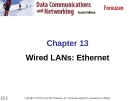
Physical layer protocols
-
After completing this chapter, students will be able to: Explain the role of Physical layer protocols and services in supporting communication across data networks, describe the role of signals used to represent bits as a frame as the frame is transported across the local media, describe the purpose of Physical layer signaling and encoding as they are used in networks.
 87p
87p  youcanletgo_01
youcanletgo_01
 04-01-2016
04-01-2016
 70
70
 6
6
 Download
Download
-
In chapter 4, students will be able to: Explain how physical layer protocols and services support communications across data networks, build a simple network using the appropriate, explain the role of the data link layer in supporting communications across data networks, compare media access control techniques and logical topologies used in networks.
 66p
66p  youcanletgo_01
youcanletgo_01
 29-12-2015
29-12-2015
 69
69
 4
4
 Download
Download
-
In 1985, the Computer Society of the IEEE started a project, called Project 802, to set standards to enable intercommunication among equipment from a variety of manufacturers. Project 802 is a way of specifying functions of the physical layer and the data link layer of major LAN protocols.
 40p
40p  trada85
trada85
 22-01-2013
22-01-2013
 55
55
 8
8
 Download
Download
-
lập kết nối giữa 2 hostApplication Presentation Session Transport Network Data link Physical TẦNG MẠNG VS TẦNG VẬN CHUYỂNVí dụ: A gởi B 1 bức thư qua đường bưu điện ¢ processes = A, B ¢ app messages = bức thư ¢ hosts = nhà của A, nhà của B Dựa trên, mở rộng dịch vụ ¢ transport protocol ??? của tầng mạng ¢ network-layer protocol
 37p
37p  abcdef_15
abcdef_15
 27-07-2011
27-07-2011
 145
145
 17
17
 Download
Download
-
The Data-Link layer is the protocol layer in a program that handles the moving of data in and out across a physical link in a network. The Data-Link layer is layer 2 in the Open Systems Interconnect (OSI) model for a set of telecommunication protocols.The Data-Link layer ensures that an initial connection has been set up, divides output data into data frames, and handles the acknowledgements from a receiver that the data arrived successfully. It also ensures that incoming data has been received successfully by analyzing bit patterns at special places in the frames....
 64p
64p  thanhtq00103
thanhtq00103
 08-06-2011
08-06-2011
 147
147
 14
14
 Download
Download
-
Explain the role of Physical layer protocols and services in supporting communication across data networks.
 50p
50p  asvenus
asvenus
 24-05-2011
24-05-2011
 106
106
 8
8
 Download
Download
-
Physical Layer. In this chapter, you will learn to: Explain the role of Physical layer protocols and services in supporting communication across data networks. Describe the purpose of Physical layer signaling and encoding as they are used in networks. Describe the role of signals used to represent bits as a frame is transported across the local media. Identify the basic characteristics of copper, fiber, and wireless network media.
 42p
42p  thanhtung_hk
thanhtung_hk
 03-11-2010
03-11-2010
 134
134
 24
24
 Download
Download
-
SYSTEM ANALYSIS FUNDAMENTALS FUNDAMENTALS OF SYSTEM ANALYSIS Third generation systems focus on providing a universal platform to afford multifarious communications options at all levels, i.e. the radio as well as the core network sides. This implies the application of optimum techniques in multiple access and interworking protocols for the physical and upper layers, respectively.
 28p
28p  doroxon
doroxon
 12-08-2010
12-08-2010
 105
105
 12
12
 Download
Download
-
Identify the basic characteristics of network media used in Ethernet. Describe the physical and data link features of Ethernet. Describe the function and characteristics of the media access control method used by Ethernet protocol. Explain the importance of Layer 2 addressing used for data transmission and determine how the different types of addressing impacts network operation and performance. Compare and contrast the application and benefits of using Ethernet switches in a LAN as apposed to using hubs....
 94p
94p  thangvu89
thangvu89
 15-04-2010
15-04-2010
 186
186
 28
28
 Download
Download
-
Explain the role of Physical layer protocols and services in supporting communication across data networks. – Describe the role of signals used to represent bits as a frame as the frame is transported across the local media Describe the purpose of Physical layer signaling and encoding as they are used in networks Identify the basic characteristics of copper, fiber and wireless network media Describe common uses of copper, fiber and wireless network media
 54p
54p  thangvu89
thangvu89
 15-04-2010
15-04-2010
 190
190
 36
36
 Download
Download
CHỦ ĐỀ BẠN MUỐN TÌM






















